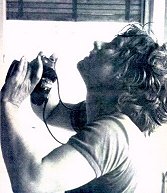--------------------------------------------------------------------------------
--------------------------------------------------------------------------------
http://www.the-artists.org/ArtistView.cfm?id=FC28B49F-3097-41C2-A942807428666A77
Gordon Matta-Clark
Born 1943, New York, USA. Died 1978. Son of Roberto Matta, Chilean painter.
--------------------------------------------------------------------------------
http://freespace.virgin.net/robert.holloway/gordon.html
Nobody could deconstruct buildings the way Gordon destructed them.
Ted Castle
Ted Castle, Gordon Matta-Clark, Flash Art/Heute Kunst 90-91, June-July 1979, p.37
Actually, as far as I know, he didn't believe in building anything; he was taking things apart and unbuilding.
Alan Saret
interview with Joan Simon, printed in Mary Jane Jacobs, Gordon Matta- Clark: A Retrospective, exhib. cat., Museum of Contemporary Art, Chicago 1985
He was a deconstructionist; his approach was to pull things apart.
Laurie Anderson
interview with Joan Simon, printed in Mary Jane Jacobs, Gordon Matta- Clark: A Retrospective, exhib. cat., Museum of Contemporary Art, Chicago 1985
From the beginning, Matta-Clark's work was a fusion of media. His approach to making constituted a real choreography (a coordinating of skills in different art media), whose techniques ranged from cooking to alchemy, from social situations to happenings, from archaeological digs to commemorative digs, from drawing to film making, from collection to repossession, from buying property to offering fresh air, from cutting buildings to splicing photographs, from constructions of the destroyed to destructions of closure. All of these methods were precariously balanced over a void, between opposites, between heaven and earth, reality and its suspension. The space that was left behind was a space between, simultaneously critical, dangerous, disorienting, reorienting, full of potential, traversed by energy and hope.
Matta-Clark's manner of working was like a performance, and this theatrical mood extended to the viewer's experience of the site. In the six years in which Matta-Clark cut buildings, he moved from simple, discrete, rectangular shapes to slices whose overlapping created further complexity. Yet these increases in complexity also meant an increase in the fear of visiting the works, and seeing them at first hand. The cuts would often produce worry that one would fall through, and one's own safety would be questioned.
However, there is a paradox in considering the work of Matta- Clark today, since all of his works are destroyed. One is inevitably removed from a physical relationship with the work, from the kind of sublime sensation of the abyss, of standing at the edge. The buildings are no longer deconstructed; they are reconstructed in the form of photomontage. No longer is one filled with the physical, phenomenological threat of being inside one of the buildings. The buildings are no longer disintegrated, they are in a way renewed with a different identity, and from being abandoned and marginal, they are reclaimed, and in the image one sees the reconstitution of the space.
--------------------------------------------------------------------------------
--
The Design-L list for art and architecture, since 1992...
To subscribe, send mailto:design-l-subscribe-request@xxxxxxxxxxxxx.
To signoff, send mailto:design-l-unsubscribe-request@xxxxxxxxxxxxx.
Visit archives: http://lists.psu.edu/archives/design-l.html

















